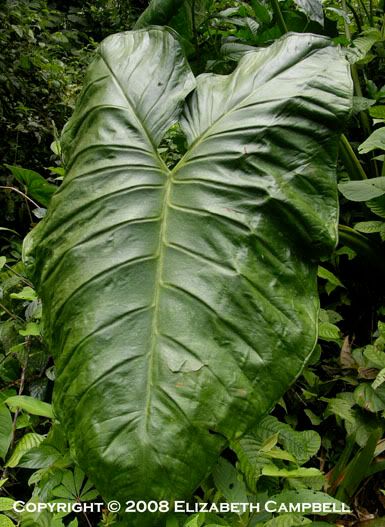To elaborate a little bit on what I was saying earlier, and hopefully make myself a bit clearer:
Colocasia: Petiole about the same length as the leaves or shorter, defined posterior lobes with small fusion towards the sinus, leaf shape more oblate (rounder), petioles are normally coloured (rather than the leaves) and quite stocky, velvet leaf surface, round tubers. Leaf blades often very very large. Leaves normally reflexed (point down), although some species are erect.
C. esculenta

Alocasia: Petioles normally longer than leaf blades, well-defined posterior lobes with small fusion towards the sinus, leaf shape more saggitate (arrow shaped), petioles normally green or purple and quite delicate, highly coloured leaves, waxy leaf surface, long tubers. Alocasias are often smaller leaves. Leaves normally reflexed (point down), although some species are erect.
Alocasia 'Amazonica'

Ready for the exceptions?
Alocasia odora (and
A. macrorrhiza, a very similar species) bears HUGE erect leaves with a somewhat velvety-leathery texture, which superficially resembles Colocasias.
 Colocasia gigantea
Colocasia gigantea is also HUGE erect leaves with a somewhat velvety-leathery texture. The only visual difference between it and
A. odora, without digging it up to look at the bulbs, is that there is more fusion of the posterior lobes.

And if you want a real mindbender,
Xanthosoma saggitafolium - which is also referred to as an Elephant Ear, is sometimes sold in garden centers, is an edible, but is neither Colocasia nor Alocasia. This has huge reflexed saggitate leaves with a velvety-leathery texture, petioles longer than the leaves and much thicker than those of Alocasia or Colocasia. This is another edible Aroid, native to Ecuador. Xanthosoma are superficially very similar to Colocasia, with the giveaway being a more elongated and much larger tuber, the more leathery texture of the leaves, and the lack of fusion in the posterior lobes of the leaf. The one in the photo, which is a wild specimen, had a leaf blade in excess of 5' from the tip of the posterior lobes to the point of the leaf.

And of course, since we're dealing with members of the Aracea, the bottom line is that all species are VERY variable - so all these handy little guidelines only apply to a portion of the plants of any given species. There are Colocasias with waxy leaves, and Alocasias with a high degree of posterior-lobe fusion, and Xanthosomas may have fine petioles. I can only ID them on sight because I've been doing it for a long time, and even now I still make mistaken IDs and have to check the tubers - I grow examples of all three genera, and forage Xanthosoma and escapee Colocasia in the forests, and I still get them mixed up sometimes. Best of luck!